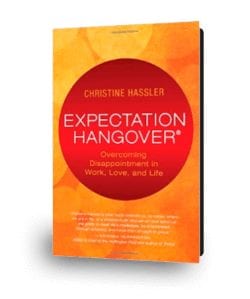HOW TO REALLY FEEL YOUR FEELINGS
 I have been reading Expectation Hangover by Christine Hassler and loving all her tools and strategies. As I am going through the book I wanted to share some of them with you.
I have been reading Expectation Hangover by Christine Hassler and loving all her tools and strategies. As I am going through the book I wanted to share some of them with you.
She breaks the book down into four categories starting with dealing with feelings after an expectation hangover.
We have a similar approach to dealing with feelings…
RELEASING VS RECYCLING FEELINGS
Feelings get recycled rather than released when you try to interpret, blame, figure out or fix them – rather than allowing them to be expressed.
Releasing a feeling is when you allow yourself to express it without any judgment, analysis, interpretation or desire to get out of it.
The more you try to get out of feeling your feelings, the more baggage you store up from your past unresolved issues that trigger the same feelings.
This exercise will help you bring unresolved issues you have repressed from your past into your consciousness.
 UNCOVERING REYCLED FEELINGS
UNCOVERING REYCLED FEELINGS
- Find a quiet place to sit and ask yourself what feelings are you experiencing?
- Do these feelings remind you of something from your past? How does this feel familiar?
- I have felt this before when…
- This reminds me of…
- I remember when..
Now you can understand how your feelings may have been tied to your experiences from the past and helps prepare you to release them…
HOW TO RIDE YOUR EMOTIONS
“I used to fight the pain, but pain is not my enemy. It is my call to greatness. Learning what you are made of is always time well spent.” ~Henry Rollins
Emotions need a way to get out. If you do not express them, they will find another exit…
Unprocessed sadness creates lethargy and even depression.
Unexpressed anger can manifest in irritability and anxiety.
If you find yourself snapping at people, road raging, feeling upset over things that don’t normally upset you.
If you constantly feel “blah” and passionless and look for external things to make you feel happy or use avoidance strategies like eating, drinking, shopping or keeping busy.
It’s time to really face your feelings!
Step One: Become A Surfer
 A surfer paddles out into the ocean completely willing to face the waves.
A surfer paddles out into the ocean completely willing to face the waves.
She has no control over the waves that come in, but she does have a choice on how she responds to it.
The surfer allows the wave to carry her and relies on her surfing skills to keep her safe.
The surfer rides the wave, no matter how big or scary, without judgment, analysis or desire to get out of the situation.
If she attempts to avoid, overpower or swim against the wave, she will never get the chance to experience the thrill and freedom that comes from riding the wave all the way through.
Your emotions, just like the waves, have peaks that will gradually subside and land you softly back on the beach.
Think of a child’s temper tantrum:
 The child gets upset about something, the emotion escalates usually from frustration to anger.
The child gets upset about something, the emotion escalates usually from frustration to anger.
Then tears and sobbing begins as sadness and disappointment well up.
If the child is given time to feel all the feelings, the emotions subside, exhaustion hits and acceptance finally sets in.
Then she heads back to play.
The child does not get to the other side of her temper tantrum if someone comes in and tries to stop it.
Similarly, it is impossible to get to peace and acceptance of you interrupt your feelings before you fully express them.
Processing emotions means allowing yourself to fully experience all your emotions.
Step Two: Self Compassion
You may have avoided your emotions, because you worry you will fall into a deep hole of pain and despair and never get out.
The word compassion means being “with suffering.”
You can create a part of you that is unconditionally loving and nurturing.
Who gives you permission and encouragement to express your feelings fully.
Think of a person or pet you love unconditionally and bring up those feelings.
Now take all that love, compassion and acceptance you are feeling and direct them toward yourself.
See yourself through the eyes of love – this is compassion.
Without self-compassion, the same feeling will continue to get triggered.
Click here to learn Steps 3 & 4.


 UNCOVERING REYCLED FEELINGS
UNCOVERING REYCLED FEELINGS



Recent Comments